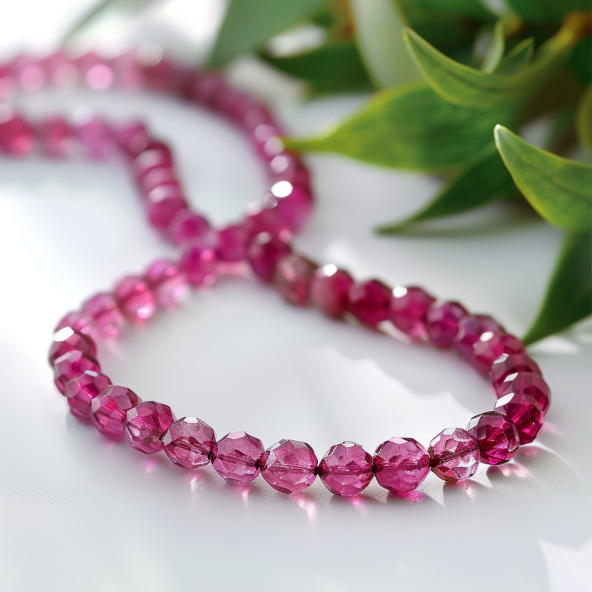4Cs Work in Rubellite Tourmaline
Rubellite Tourmaline is a gemstone that dazzles with its rich red hues and vibrant brilliance. When purchasing this beautiful gemstone, understanding how the 4Cs work in Rubellite Tourmaline is essential to ensure you’re choosing the best quality stone. The 4Cs—Color, Clarity, Cut, and Carat Weight—are the primary factors that determine the value and appearance of Rubellite Tourmaline. In this blog, we will explore how the 4Cs work in Rubellite Tourmaline, providing you with the knowledge to make an informed purchase.

Color: The Most Important C in Rubellite Tourmaline
When discussing how the 4Cs work in Rubellite Tourmaline, color is undoubtedly the most crucial factor. Rubellite Tourmaline is prized for its intense red to pinkish-red hues, often with a slight purplish tint. The best Rubellite Tourmalines display a vibrant and evenly distributed color without any zoning (areas of varying color within the stone).
- Deep Red: The most valuable Rubellite Tourmalines exhibit a deep, rich red color that remains consistent under different lighting conditions. This saturation is key to the stone’s appeal and market value.
- Pinkish-Red: Some Rubellite Tourmalines lean more toward a pinkish-red hue, which can also be highly desirable. These stones often have a softer, more romantic appearance.
- Purplish Tint: A purplish tint can add depth to the stone’s color, making it unique and often more sought after by collectors.
When choosing a Rubellite Tourmaline, prioritize stones with vivid, intense color that is evenly spread throughout the gem.
Clarity: The Impact of Inclusions
Clarity is the second most important factor in understanding how the 4Cs work in Rubellite Tourmaline. Clarity refers to the presence of internal inclusions or blemishes within the gemstone. In Rubellite Tourmaline, inclusions are common and can sometimes add character to the stone. However, too many or large inclusions can detract from the gemstone’s beauty and value.
- Eye-Clean Stones: The most desirable Rubellite Tourmalines are eye-clean, meaning they have no visible inclusions when viewed with the naked eye. These stones are rare and command higher prices.
- Acceptable Inclusions: Because inclusions are common in Rubellite Tourmaline, stones with minor inclusions that do not affect the overall appearance or durability are still considered valuable.
- Feather and Needle Inclusions: These are typical inclusions found in Rubellite Tourmaline. While they can add uniqueness to the stone, ensure they do not significantly impact the gem’s brilliance.

When selecting a Rubellite Tourmaline, balance clarity with color. A stone with exceptional color may still be valuable even with minor inclusions.
Cut: Maximizing Brilliance and Color
The cut of Rubellite Tourmaline plays a crucial role in how the gemstone reflects light and displays its color. Understanding how the 4Cs work in Rubellite Tourmaline involves recognizing the importance of a well-executed cut.
- Faceted Cuts: Faceted cuts are popular for Rubellite Tourmaline because they enhance the gemstone’s brilliance and showcase its vibrant color. Common cuts include oval, cushion, and emerald.
- Symmetry and Proportions: A well-cut Rubellite Tourmaline will have excellent symmetry and proportions, ensuring that light is reflected evenly across the stone. This enhances both the color and brilliance.
- Cabochon Cut: In some cases, Rubellite Tourmaline is cut as a cabochon (a polished, non-faceted stone). This cut is often used when the stone has too many inclusions for faceting but still has a desirable color.
When choosing a Rubellite Tourmaline, look for a cut that enhances the stone’s natural beauty and maximizes its visual appeal.
Carat Weight: Size and Its Impact on Value
Carat weight is the final factor in understanding how the 4Cs work in Rubellite Tourmaline. The size of the gemstone, measured in carats, can significantly impact its value, but it’s essential to consider it alongside the other three Cs.
- Larger Stones: Larger Rubellite Tourmalines are rarer and can command higher prices, especially if they possess excellent color and clarity.
- Smaller Stones: Smaller stones can be equally beautiful and valuable, particularly if they have a deep, vivid color and are well-cut.
- Balancing Size with Quality: When choosing a Rubellite Tourmaline, consider how the carat weight balances with the stone’s color, clarity, and cut. A smaller stone with exceptional color and clarity may be more valuable than a larger stone with lower quality.
Understanding how the 4Cs work in Rubellite Tourmaline is essential for making an informed purchase. By considering color, clarity, cut, and carat weight, you can choose a gemstone that not only fits your aesthetic preferences but also offers excellent value. Whether you’re looking for a statement piece or a subtle addition to your jewelry collection, Rubellite Tourmaline is a gemstone that will captivate with its vibrant beauty and timeless appeal.
Embark on a journey into the captivating world of gemstones with our Introduction to Rubellite Tourmaline.
